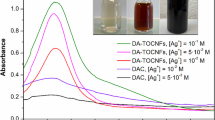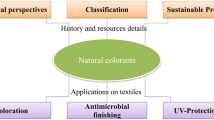Abstract
A lightweight, portable, low-cost, and accessible cotton swab was employed as surface enhanced Raman spectroscopy (SERS) matrix template. The silver nanoflowers were in situ grown on the surface of cotton swabs to form three-dimensional Ag nanoflower@cotton swabs (AgNF@CS) SERS substrate with high-density and multi-level hot spots. The SERS performance of AgNFs@CS substrates with various reaction time was systematically studied. The optimal AgNF-120@CS SERS substrate exhibits superior detection sensitivity of 10−10 M for methylene blue, good signal reproducibility, high enhancement factor of 1.4 × 107, and excellent storage stability (over 30 days). Moreover, the AgNF-120@CS SERS substrate also exhibits prominent detection sensitivity of 10−8 M for food colorant of carmine. Besides, the portable AgNF-120@CS SERS substrate is also capable of detecting food colorant residues on irregular food surfaces.
Graphical abstract







Similar content being viewed by others
Data availability
Data will be made available on request.
References
Gukowsky JC, Xie T, Gao S, Qu Y, He L (2018) Rapid identification of artificial and natural food colorants with surface enhanced Raman spectroscopy. Food Control 92:267–275
Itoh T, Procházka M, Dong Z-C, Ji W, Yamamoto YS, Zhang Y (2023) Toward a new era of SERS and TERS at the nanometer scale: from fundamentals to innovative applications. Chem Rev 123(4):1552–1634
Xue D, Dai X, Zhao J, Zhang J, Liu H, Liu K (2024) Therapeutic drug monitoring mediated by the cooperative chemical and electromagnetic effects of Ti3C2TX modified with Ag nanocubes. Biosen Bioelectron 245:115844
Li F, Mu X, Tang X, Song G, Sun H, Zha X (2023) Semiconductor SERS on colourful substrates with Fabry-Pérot cavities. Angew Chem Int Edit 135(12):e202218055
Schmidt MM, Farley EA, Engevik MA, Adelsman TN, Tuckmantel Bido A, Lemke ND (2023) High-speed spectral characterization of single-molecule SERS fluctuations. ACS Nano 17(7):6675–6686
Kim D, Kim J, Henzie J, Ko Y, Lim H, Kwon G (2021) Mesoporous Au films assembled on flexible cellulose nanopaper as high-performance SERS substrates. Chem Eng J 419:129445
Zhang S, Jin K, Xu J, Ding L, Huang Y, Liu G (2024) Aramid nanofiber membrane decorated with monodispersed silver nanoparticles as robust and flexible SERS chips for trace detection of multiple toxic substances. Spectrochim Acta A 308:123720
Li X, Zhang T, Chen Z, Yu J, Cao A, Liu D (2022) Au polyhedron array with tunable crystal facets by PVP-assisted thermodynamic control and its sharp shape as well as high-energy exposed planes Co-boosted SERS activity. Small 18(4):2105045
Zhang T, Li X, Li C, Cai W, Li Y (2021) One-pot synthesis of ultrasmooth, precisely shaped gold nanospheres via surface self-polishing etching and regrowth. Chem Mater 33(7):2593–2603
Xing C, Liu D, Chen J, Fan Y, Zhou F, Kaur K (2021) Convective self-assembly of 2D nonclose-packed binary Au nanoparticle arrays with tunable optical properties. Chem Mater 33(1):310–319
Kumar S, Tokunaga K, Namura K, Fukuoka T, Suzuki M (2020) Experimental evidence of a twofold electromagnetic enhancement mechanism of surface-enhanced Raman scattering. J Phys Chem C 124(38):21215–21222
Botta R, Limwichean S, Limsuwan N, Moonlek C, Horprathum M, Eiamchai P (2022) An efficient and simple SERS approach for trace analysis of tetrahydrocannabinol and cannabinol and multi-cannabinoid detection. Spectrochim Acta A 281:121598
Botta R, Eiamchai P, Horprathum M, Limwichean S, Chananonnawathorn C, Patthanasettakul V (2018) Investigation of silver nanorods as reusable SERS-active substrates for trace level detection of 2-MIB volatile organic compound. Sensor Actuat B Chem 271:122–127
Botta R, Eiamchai P, Horprathum M, Limwichean S, Chananonnawathorn C, Patthanasettakul V (2020) 3D structured laser engraves decorated with gold nanoparticle SERS chips for paraquat herbicide detection in environments. Sensor Actuat B Chem 304:127327
Sajitha M, Abraham B, Nelliyil RB, Yoosaf K (2021) Chemically etched nanoporous copper and galvanically displaced silver nanoflowers for SERS sensing. ACS Appl Nano Mater 4(10):10038–10046
Nistico R, Rivolo P, Novara C, Giorgis F (2019) New branched flower-like Ag nanostructures for SERS analysis. Colloid Surface A 578:123600
Qiu H, Wang M, Jiang S, Zhang L, Yang Z, Li L (2017) Reliable molecular trace-detection based on flexible SERS substrate of graphene/Ag-nanoflowers/PMMA. Sensor Actuat B Chem 249:439–450
Cheng D, He M, Ran J, Cai G, Wu J, Wang X (2018) Depositing a flexible substrate of triangular silver nanoplates onto cotton fabrics for sensitive SERS detection. Sensor Actuat B Chem 270:508–517
Khatoon UT, Rao GN, Mantravadi KM, Oztekin Y (2018) Strategies to synthesize various nanostructures of silver and their applications–a review. RSC Adv 8(35):19739–19753
Zhang S, Xu J, Liu Z, Huang Y, Fu R, Jiang S (2022) Facile and scalable preparation of solution-processed succulent-like silver nanoflowers for 3D flexible nanocellulose-based SERS sensors. Surf Interfaces 34:102391
Wang D, Wang F, Yang H (2018) Robust, flexible, sticky and high sensitive SERS membrane for rapid detection applications. Sensor Actuat B Chem 274:676–681
Zhang D, Pu H, Huang L, Sun DW (2021) Advances in flexible surface-enhanced Raman scattering (SERS) substrates for nondestructive food detection: Fundamentals and recent applications. Trends Food Sci Tech 109:690–701
Li Z, Huang X, Lu G (2020) Recent developments of flexible and transparent SERS substrates. J Mater Chem C 8(12):3956–3969
Xia D, Jiang P, Cai Z, Zhou R, Tu B, Gao N (2022) Ag nanocubes monolayer-modified PDMS as flexible SERS substrates for pesticides sensing. Microchim Acta 189(6):232
Zhang S, Xu J, Huang Y, Liu Z, Jiang S (2022) Monodisperse Ag nanoparticle-decorated bacterial nanocellulose as flexible surface-enhanced Raman scattering sensors for trace detection of toxic thiram. ACS Appl Nano Mater 5(12):18519–18530
Song X, Zhang Y, Ren X, Zhang X, Tang D, Wu J (2023) Fabrication of flexible multidimensional CC/MoS2@Ag@PDMS hybrids as stable and self-cleaning SERS substrate for sensitive and quantitative point-of-care testing. Sensors Actuat B Chem 394:134439
Sunil N, Unnathpadi R, Pullithadathil B (2023) Label-free SERS salivary biosensor based on Ni@Ag core–shell nanoparticles anchored on carbon nanofibers for prediagnosis of lung cancer. ACS Appl Nano Mater 6(13):11334–11350
Kumar S, Goel P, Singh JP (2017) Flexible and robust SERS active substrates for conformal rapid detection of pesticide residues from fruits. Sensors Actuat B Chem 241:577–583
Guo Z, Zheng Y, Yin L, Xue S, Ma L, Zhou R (2024) Flexible Au@AgNRs/MAA/PDMS-based SERS sensor coupled with intelligent algorithms for in-situ detection of thiram on apple. Sensors Actuat B Chem 404:135303
Wei X, Song W, Fan Y, Sun Y, Li Z, Chen S (2024) A SERS aptasensor based on a flexible substrate for interference-free detection of carbendazim in apple. Food Chem 431:137120
Sang Y, Chen X, Zhang L, Li D, Xu H (2021) Electrospun polymeric nanofiber decorated with sea urchin-like gold nanoparticles as an efficient and stable SERS platform. J Colloid Interface Sci 590:125–133
Gong Z, Du H, Cheng F, Wang C, Wang C, Fan M (2014) Fabrication of SERS swab for direct detection of trace explosives in fingerprints. ACS Appl Mater Interfaces 6(24):21931–21937
Qu LL, Geng YY, Bao ZN, Riaz S, Li H (2016) Silver nanoparticles on cotton swabs for improved surface-enhanced Raman scattering, and its application to the detection of carbaryl. Microchim Acta 183:1307–1313
Tian L, Jiang Q, Liu KK, Luan J, Naik RR, Singamaneni S (2016) Bacterial nanocellulose-based flexible surface enhanced Raman scattering substrate. Adv Mater Interfaces 3(15):1600214
Huang WC, Cheng KF, Shyu JY (2022) Flexible SERS substrate of silver nanoparticles on cotton swabs for rapid in situ detection of melamine. Nanoscale Adv 4(4):1164–1172
Pandi N, Sonawane SH, Anand Kishore K (2021) Synthesis of cellulose nanocrystals (CNCs) from cotton using ultrasound-assisted acid hydrolysis. Ultrason Sonochem 70:105353
Abol-Fotouh D, Hassan MA, Shokry H, Roig A, Azab MS, Kashyout AE-HB (2020) Bacterial nanocellulose from agro-industrial wastes: low-cost and enhanced production by Komagataeibacter saccharivorans MD1. Sci Rep 10(1):1–14
Liu C, Yang X, Yuan H, Zhou Z, Xiao D (2007) Preparation of silver nanoparticle and its application to the determination of ct-DNA. Sensors 7(5):708–718
Ruby A, Mehata MS (2022) Surface plasmon resonance allied applications of silver nanoflowers synthesized from Breynia vitis-idaea leaf extract. Dalton T 51(7):2726–2736
El-Sayed MA (2001) Some interesting properties of metals confined in time and nanometer space of different shapes. Accounts Chem Res 34(4):257–264
Xiao GN, Man SQ (2007) Surface-enhanced Raman scattering of methylene blue adsorbed on cap-shaped silver nanoparticles. Chem Phys Lett 447(4):305–309
Santhoshkumar S, Murugan E (2021) Rationally designed SERS AgNPs/GO/g-CN nanohybrids to detect methylene blue and Hg2+ ions in aqueous solution. Appl Surf Sci 553:149544
Li Y, Li P, Chen Y, Wu Y, Wei J (2023) Interfacial deposition of Ag nanozyme on metal-polyphenol nanosphere for SERS detection of cellular glutathione. Biosen Bioelectron 228:115200
Kong L, Huang M, Chen J, Lin M (2020) Fabrication of sensitive silver-decorated cotton swabs for SERS quantitative detection of mixed pesticide residues in bitter gourds. New J Chem 44(29):12779–12784
Wang Y, Wang M, Sun X, Shi G, Zhang J, Ma W (2018) Grating-like SERS substrate with tunable gaps based on nanorough Ag nanoislands/moth wing scale arrays for quantitative detection of cypermethrin. Opt Exp 26(17):22168–22181
Feng C, Wang X, Yang J, Xi S, Jia M, Shen J (2022) Silver nanoparticle-decorated chitosan aerogels as three-dimensional porous surface-enhanced Raman scattering substrates for ultrasensitive detection. ACS Appl Nano Mater 5(4):5398–5406
Wu YX, Liang P, Dong QM, Bai Y, Yu Z, Huang J (2017) Design of a silver nanoparticle for sensitive surface enhanced Raman spectroscopy detection of carmine dye. Food Chem 237:974–980
Funding
Prof. Shouxiang Jiang: Hong Kong Innovation Technology Funding (No. PRP/104/20TI). Prof. Sihang Zhang: Start-up Fund for High-level Talents of Hainan University (KYQD(ZR)23098), Hainan Provincial Natural Science Foundation of China (224MS003), Innovation and Technology Commission (ITC) of the Hong Kong SAR Government for “Research Talent Hub” Postdoctoral Fellowship Scheme (RTH-ITF, No. PiH/253/21). Prof. Long Wu: Key Laboratory of Tropical Fruit and Vegetable Quality and Safety for State Market Supervision (ZX-2023001).
Author information
Authors and Affiliations
Contributions
SZ: conceptualization, methodology, investigation, writing—original draft, writing—review and editing, visualization. KJ: methodology, investigation. JX and JX: visualization, investigation. LD: methodology, investigation. LW: conceptualization, supervision and funding acquisition. XL: conceptualization, supervision and funding acquisition. ZD: writing—review and editing, supervision. SJ: writing—review and editing, supervision, funding acquisition.
Corresponding authors
Ethics declarations
Ethics approval
This research did not involve human or animal samples.
Conflict of interest
The authors declare no competing interests.
Additional information
Publisher's Note
Springer Nature remains neutral with regard to jurisdictional claims in published maps and institutional affiliations.
Supplementary Information
Below is the link to the electronic supplementary material.
Supplementary file2 (MOV 575 KB)
Rights and permissions
Springer Nature or its licensor (e.g. a society or other partner) holds exclusive rights to this article under a publishing agreement with the author(s) or other rightsholder(s); author self-archiving of the accepted manuscript version of this article is solely governed by the terms of such publishing agreement and applicable law.
About this article
Cite this article
Zhang, S., Jin, K., Xu, J. et al. Cotton swabs wrapped with three-dimensional silver nanoflowers as SERS substrates for the determination of food colorant carmine on irregular surfaces. Microchim Acta 191, 222 (2024). https://doi.org/10.1007/s00604-024-06292-6
Received:
Accepted:
Published:
DOI: https://doi.org/10.1007/s00604-024-06292-6




